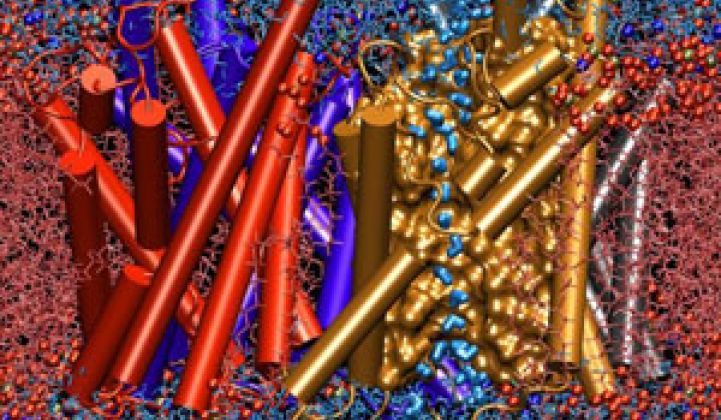MALMO, Sweden -- The Vortex Generator is probably one of the few high-tech products inspired by a trout.
The Generator, a large funnel-like device created by Sweden's Watreco, purifies water with the same forces a trout uses to stay steady in a rushing stream. Water gets poured in the top of the generator, swirls through an ever-tightening coil of channels, and then spits out the other end fleeced of harmful chemicals and microbes. Water mixed with coffee grounds? Toilet water? It comes out clear.
The impurities are ejected because the swirling action of the draining water causes them to converge into a dense, removeable beam, sort of like how tea leaves bunch together when you swirl a cup fast. A vacuum at the base of the Generator then sucks them out. There are no moving parts and little, if any, external power.
"You either are against it and don't believe it, or you say there might be something in it," says CEO Mats Eliasson.
An Austrian forestry expert named Viktor Schauberger championed ideas about natural water flow in the first few decades of the 20th century, said CTO Curt Hallberg. He was derided as a kook, particularly when he brought up the part about the fish, but his ideas are gaining new currency. (Fish can do this because water rushes into their mouths and swirls out the gills.). Schauberger concocted something called the Trout Turbine and the Vortex Generator sort of evolved from that line of thinking.
PARC, the tech lab spun out from Xerox, has come up with a spiral that can purify water in a similar manner (see Toner Tech Clears Water).
When it comes to water technology, nature appears poised to become a major player. Similar to the Watreco and Parc situation, a group of startups – Novozymes and Aquaporin – are facing off against an industrial giant – Danfoss – in an effort to create a water-purification system based around a synthetic version of a protein called aquaporin.
In nature, aquaporins sit inside channels in biological cells where water, salts and solids pour in. At a particular instant, the aquaporin flips over, ejecting the impurities and allowing fresh water to pass through the cell. Novozymes is working on the protein and Aquaporin the company is building membranes and arrays to hold them. They hope to get workable water-purification units to semiconductor makers by 2011 or so and then may go after the desalination market.
"It needs one fifth of the pressure of reverse osmosis and you get five times the water flow," said Aquaporin CEO Peter Holme Jensen. The picture above is an artist's illustration of the protein in action.
Synthetic biology (creating molecules found in nature through synthetic, industrial processes) and biomimicry (industrial design that exploits a design advantage in nature.) are already part of the startup world. Pax Scientific, funded in part by Khosla Ventures, has come up with an energy-efficient PC fan. Cambrios, founded by MIT professor Angela Belcher, has devised semiconductor insulating material based on secretions of bacteria (see CNET story).
But the trend could be particularly promising in water. Why? It's everywhere, even Mars. Natural ways to channel the stuff have evolved over eons. Water purification companies also aren't transforming the molecule. They want to take out added impurities, but they aren't making the stuff or removing atoms. Compare that to the effort to synthetically harness the photosynthesis process.
Third, interest and investment in water technology is growing at a time when synthetic biology and biomimicry are gaining credence (see Investors High on Water and Water-Investment Drought Over?). It wasn't the case five years ago. When venture capitalist Steve Jurvetson, an early advocate, would give talks on synthetic biology, a lot of people would raise their eyebrows in incomprehension.
Fourth, commercialization isn't that far off for some of these devices. Watreco, in fact, already sells a version of its generator for making ice. Ice rinks in Sweden, Detroit and New York have installed its REALice system. REALice eliminates particles and dissolved gases in water before it gets frozen. This results in a "fast" ice, says Eliasson, a former hockey player.
But there are other advantages as well. Water from de-gassed ice is harder, which means the rink can be kept at a higher temperature. The ice also can transmit heat between the outside air and the heat exchanger below the floor of the rink more efficiently than regular ice. Rink owners also don't need to heat the ice before freezing it.
In all, a small rink can save 130,000 kilowatt/hours of power a year with it, said Hallberg.
As an added bonus, the technology has sort of a new-agey "Donovan in Atlantis" flair to it. Hallberg can point out that the spiral – the shape that the water assumes when going down the Vortex Generator – is also reflected in the shape of animal horns, nebula and some drawings of UFOs that Schauberger did during his life. Eggs? He can tell you why the shape is one of the most perfect in nature.
"The fastest way between two points is not a direct line," he said. "It is a curve." Huh? With a curve, any particles going from A to B accelerate on the downslope of the curve.
"You're not going to relate this to Fibonacci numbers are you," I asked.
Well, yes, Hallberg replied. But only for fun. When they need a variable, or a string of variables for a problem, he uses the Fibonacci sequence. But it's not related in any way to the product.
This is a business after all.



